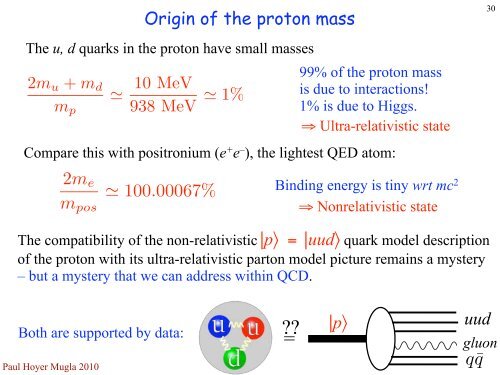Introduction to QCD slides - P.Hoyer.pdf - High Energy Physics Group
Introduction to QCD slides - P.Hoyer.pdf - High Energy Physics Group
Introduction to QCD slides - P.Hoyer.pdf - High Energy Physics Group
You also want an ePaper? Increase the reach of your titles
YUMPU automatically turns print PDFs into web optimized ePapers that Google loves.
Paul <strong>Hoyer</strong> Mugla 2010<br />
Origin of the pro<strong>to</strong>n mass<br />
The u, d quarks in the pro<strong>to</strong>n have small masses<br />
2mu + md<br />
mp<br />
�<br />
10 MeV<br />
938 MeV<br />
� 1%<br />
99% of the pro<strong>to</strong>n mass<br />
is due <strong>to</strong> interactions!<br />
1% is due <strong>to</strong> Higgs.<br />
⇒ Ultra-relativistic state<br />
Compare this with positronium (e + e – ), the lightest QED a<strong>to</strong>m:<br />
2me<br />
mpos<br />
� 100.00067%<br />
Binding energy is tiny wrt mc 2<br />
⇒ Nonrelativistic state<br />
The compatibility of the non-relativistic⎥p〉 = ⎥uud〉 quark model description<br />
of the pro<strong>to</strong>n with its ultra-relativistic par<strong>to</strong>n model picture remains a mystery<br />
– but a mystery that we can address within <strong>QCD</strong>.<br />
Both are supported by data: = ??<br />
⎥p〉<br />
uud<br />
30<br />
gluon<br />
q¯q


